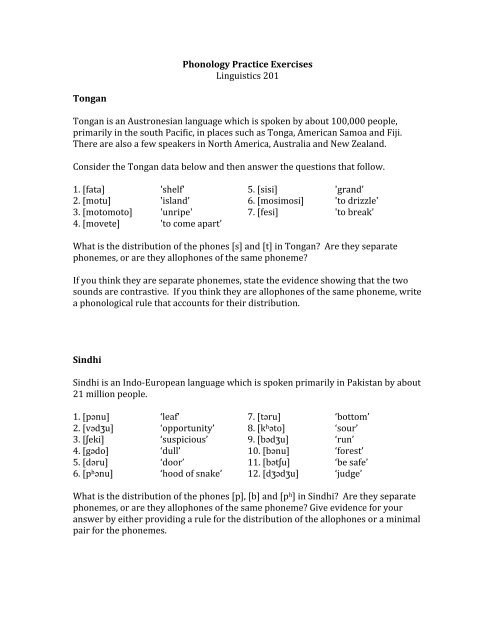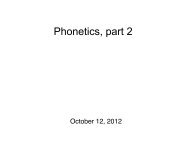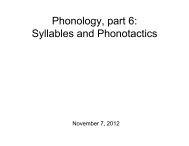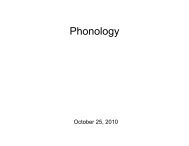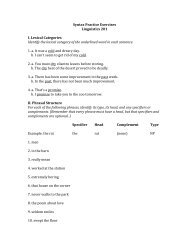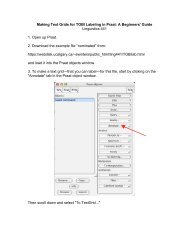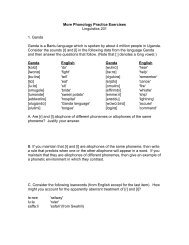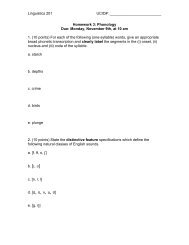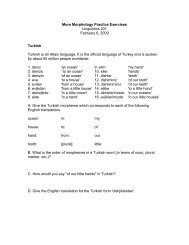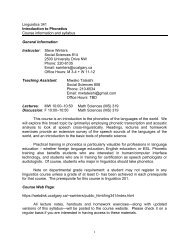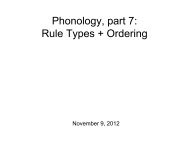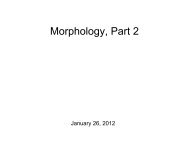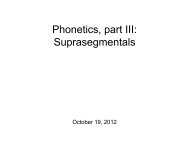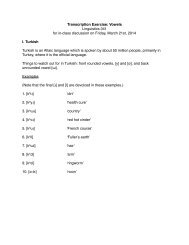Phonology Practice 1 - Basesproduced.com
Phonology Practice 1 - Basesproduced.com
Phonology Practice 1 - Basesproduced.com
You also want an ePaper? Increase the reach of your titles
YUMPU automatically turns print PDFs into web optimized ePapers that Google loves.
<strong>Phonology</strong> <strong>Practice</strong> Exercises <br />
Linguistics 201 <br />
<br />
Tongan <br />
<br />
Tongan is an Austronesian language which is spoken by about 100,000 people, <br />
primarily in the south Pacific, in places such as Tonga, American Samoa and Fiji. <br />
There are also a few speakers in North America, Australia and New Zealand. <br />
<br />
Consider the Tongan data below and then answer the questions that follow. <br />
<br />
1. [fata] 'shelf' 5. [sisi] 'grand' <br />
2. [motu] 'island' 6. [mosimosi] 'to drizzle' <br />
3. [motomoto] 'unripe' 7. [fesi] 'to break' <br />
4. [movete] 'to <strong>com</strong>e apart' <br />
<br />
What is the distribution of the phones [s] and [t] in Tongan? Are they separate <br />
phonemes, or are they allophones of the same phoneme? <br />
<br />
If you think they are separate phonemes, state the evidence showing that the two <br />
sounds are contrastive. If you think they are allophones of the same phoneme, write <br />
a phonological rule that accounts for their distribution. <br />
<br />
<br />
<br />
<br />
Sindhi <br />
<br />
Sindhi is an Indo‐European language which is spoken primarily in Pakistan by about <br />
21 million people. <br />
<br />
1. [pәnu] ‘leaf’ 7. [tәru] ‘bottom’ <br />
2. [vәdʒu] ‘opportunity’ 8. [k h әto] ‘sour’ <br />
3. [ʃeki] ‘suspicious’ 9. [bәdʒu] ‘run’ <br />
4. [gәdo] ‘dull’ 10. [bәnu] ‘forest’ <br />
5. [dәru] ‘door’ 11. [bәtʃu] ‘be safe’ <br />
6. [p h әnu] ‘hood of snake’ 12. [dʒәdʒu] ‘judge’ <br />
<br />
What is the distribution of the phones [p], [b] and [p h ] in Sindhi? Are they separate <br />
phonemes, or are they allophones of the same phoneme? Give evidence for your <br />
answer by either providing a rule for the distribution of the allophones or a minimal <br />
pair for the phonemes. <br />
<br />
<br />
<br />
Micmac <br />
<br />
Micmac is an Algonquian language which is spoken by about 7,000 people in eastern <br />
Canada, in places such as Cape Breton Island, New Brunswick, and the Gaspé <br />
Peninsula of Quebec. In fact, the name Gaspé <strong>com</strong>es from the Micmac word gespeg, <br />
meaning "land's end". <br />
<br />
1. [pis] 'flea' 7. [sipsulk] 'to cause trembling' <br />
2. [sabus] 'pierced' 8. [tibol] 'it falls' <br />
3. [talsip] 'when' 9. [sebai] 'to hunt' <br />
4. [walpok] 'pool' 10. [alispei] 'to be wet' <br />
5. [ababo] 'thread' 11. [pabi] 'play' <br />
6. [kalibu] 'caribou' 12. [apsem] 'to warm' <br />
<br />
Are [p] and [b] separate phonemes in Micmac, or are they allophones of the same <br />
phoneme? Give evidence for your answer by either providing a rule for the <br />
distribution of the allophones or a minimal pair for the phonemes. <br />
<br />
<br />
<br />
<br />
<br />
<br />
Mokilese <br />
<br />
Mokilese is another Austronesian language, which is spoken on a pair of small <br />
islands in the Federated States of Micronesia, by about 1,000 people. Examine the <br />
Mokilese data below and then answer the questions that follow. <br />
<br />
<br />
Phonetically, Mokilese has voiceless vowels (which are denoted with the diacritic for <br />
voicelessness underneath them). What is the natural class of vowels that can be <br />
devoiced in Mokilese? What is the phonetic environment which determines when <br />
these vowels be<strong>com</strong>e voiceless? <br />
<br />
<br />


